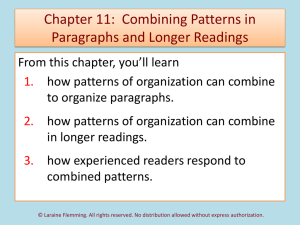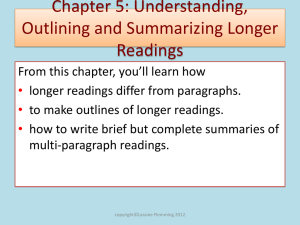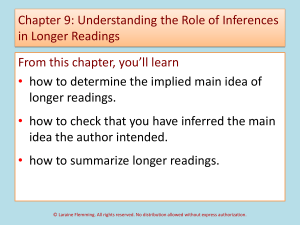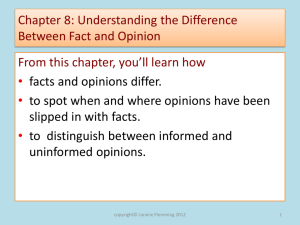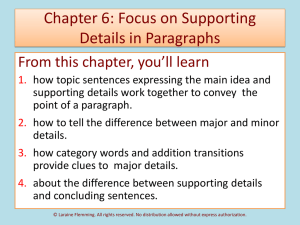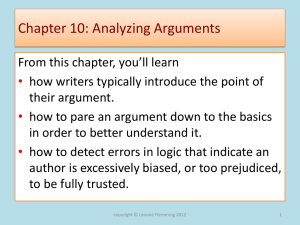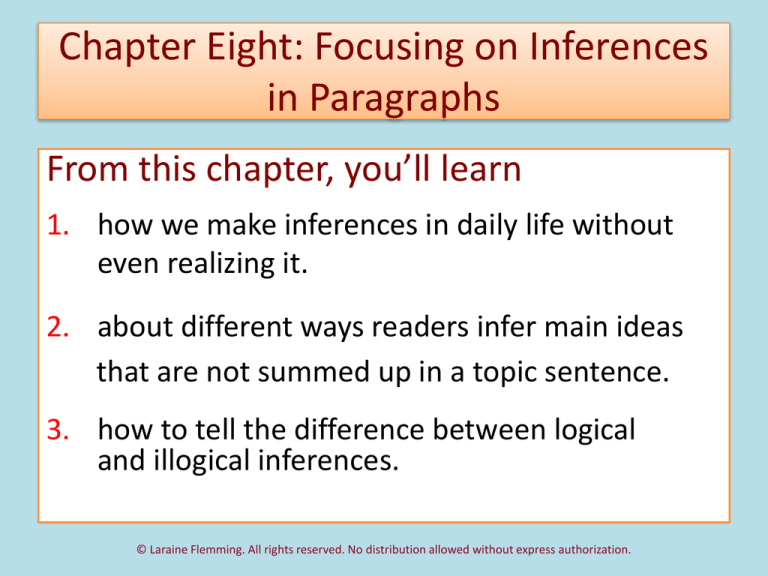
Chapter Eight: Focusing on Inferences
in Paragraphs
From this chapter, you’ll learn
1. how we make inferences in daily life without
even realizing it.
2. about different ways readers infer main ideas
that are not summed up in a topic sentence.
3. how to tell the difference between logical
and illogical inferences.
© Laraine Flemming. All rights reserved. No distribution allowed without express authorization.
Defining Terms: Inferences
Inferences are
1. conclusions we draw about the unknown based upon
the known.
2.educated guesses about something that’s been
implied, or suggested, but never said directly.
3.central to understanding an author’s or speaker’s
meaning.
4.the result of combining the meanings from specific
sentences to infer a more general main idea.
© Laraine Flemming. All rights reserved. No distribution allowed without express authorization.
Inferences in Daily Life
• If someone says, “Hey, what’s up?” we infer
that they are not asking about the state of the
ceiling but about our state of mind.
• If someone makes a joke, we often supply the
background information for the punch line,
e.g., “If you look like the photo on your
driver’s license, you aren’t well enough to
drive.”
© Laraine Flemming. All rights reserved. No distribution allowed without express authorization.
© Ulrich Flemming
A Word to the Wise
Much as you draw inferences all the time in
everyday life, you constantly draw inferences
when you read. But here again, you may not
always notice when you do. For example, taken
together, the following picture and caption make
what point?
© Laraine Flemming. All rights reserved. No distribution allowed without express authorization.
© Ulrich Flemming
Unfortunately those who have contributed the most to global
warming probably won’t be the ones paying the highest price.
© Laraine Flemming. All rights reserved. No distribution allowed without express authorization.
Drawing Inferences as a Reader
What’s the author’s point?
a. Polar bears have contributed heavily to global
warming, and they are going to pay the price
because the icebergs they rely on for mobility
are melting.
b. Humans have contributed heavily to global
warming, but polar bears are paying the price
because the icebergs they rely on for mobility
are melting.
© Laraine Flemming. All rights reserved. No distribution allowed without express authorization.
Even Pictures with Captions Need
Inferences from Readers
Most people choose answer b. It seems the
obvious answer. However, to arrive at that
obvious answer, we have to infer that the
author had the following thoughts in mind
when writing the caption for this particular
picture.
© Laraine Flemming. All rights reserved. No distribution allowed without express authorization.
Reader-Supplied Inferences
1. Humans are the ones usually mentioned as contributors to
global warming.
2. The melting of icebergs has been repeatedly cited in the
news as a consequence of global warming.
3. Because icebergs are melting, polar bears are getting
stranded in Arctic waters when they fish.
4. Polar bears rely on icebergs as places to rest on periodically
when they fish.
5. Dying in the Arctic seas will be the price that polar bears pay
as a result of global warming they did not cause.
© Laraine Flemming. All rights reserved. No distribution allowed without express authorization.
What information does the reader need to
supply to get the point of these sentences?
“Miranda was ironing her favorite blouse for work when
she was interrupted by the sound of the doorbell.
When she returned to her ironing, after a lengthy chat
with her neighbor--who had brought over some mail
delivered to the wrong address--Miranda was horrified to
see the horseshoe-shaped burn on what had once been
her favorite blouse.”
© Laraine Flemming. All rights reserved. No distribution allowed without express authorization.
© Ulrich Flemming
A Few Words to the Wise
• It’s all but impossible for writers to put every thought
essential to a text’s meaning on the page.
• Writers rely on readers to add information to the text by
drawing logical inferences or conclusions.
• Those inferences are based on a combination of the
author’s words and the reader’s background knowledge.
© Laraine Flemming. All rights reserved. No distribution allowed without express authorization.
Sometimes Inferring the Main Idea Means
Piecing Together Parts of Different Sentences
Can you combine parts of two or more
sentences to state the main idea of the
following paragraph?
© Laraine Flemming. All rights reserved. No distribution allowed without express authorization.
1Several
times over the last few decades, research studies have
suggested that drinking coffee may contribute to the onset of a
variety of diseases ranging from cancer to heart attacks. 2New
research, however, seems to contradict those previous studies.
3More recent studies emphasize the positive effects of drinking
coffee. 4Researchers at the National Institute for Diabetes and
Digestive Diseases, for instance, found that coffee drinking
significantly reduces the risk of chronic liver disease. 5Similarly,
two federal studies of American nurses found that the biggest
coffee drinkers had the lowest risk of developing high blood
pressure. 6A study done by researchers at Harvard found lower
rates of depression among people who drank coffee as opposed
to tea.
© Laraine Flemming. All rights reserved. No distribution allowed without express authorization.
When There Are No Pieces to
Combine, You Need to
1. get a sense of the key elements in the main idea by
looking for words and phrases that are repeated or
referred to throughout the paragraph.
2. ask yourself what each sentence adds to your
understanding of the person, event, or experience
being described.
3. formulate a general statement that could sum up
or include all the specific statements about the
topic.
© Laraine Flemming. All rights reserved. No distribution allowed without express authorization.
What words or phrases come up again and again
in this paragraph?
1Biographers
of the New England, local color writer
Sarah Orne Jewett always mention how Jewett adored
her doctor-father. 2They never seem to notice that in
Jewett’s fiction, doctors and fathers don’t fare very well.
3Jewett’s fictional fathers are inclined to sacrifice their
families in the name of their own extravagant dreams
and social schemes. 4Driven by their desires, they never
seem to notice the suffering they cause others. 5It’s also
true that Jewett’s fictional doctors are inclined to be
arrogant and are frequently shown up by female healers,
who rely on home remedies rather than fancy medical
treatments.
© Laraine Flemming. All rights reserved. No distribution allowed without express authorization.
Taken together, what main idea do the
sentences suggest?
a. Jewett was very good at portraying the flaws of
pompous doctors and self-serving fathers.
b. Jewett’s fiction suggests that her admiration for
her doctor-father may have had some anger
mixed in.
c. Jewett may have adored her father, but as a
local colorist, she was still inclined to follow the
literary tradition of making men look silly.
© Laraine Flemming. All rights reserved. No distribution allowed without express authorization.
© Ulrich Flemming
Just So you Know
The local color literary tradition began after the Civil War ended in
1865, when writers all across the United States were concerned that
the war’s devastation, along with the spread of cities and industry,
were destroying the customs, speech, and look of different regions in
the United States. Writers like Sarah Orne Jewett in the North,
Sidney Lanier in the South, and Bret Harte in the West tried to
preserve the characteristics of their region in the fiction they created.
They also tried to show the value of the regional traditions that were
fast disappearing under the onslaught of industrialization and passing
time.
© Laraine Flemming. All rights reserved. No distribution allowed without express authorization.
Defining Terms: Logical Inferences
Logical Inferences are
• based on the author’s words more than your personal
experience and opinions.
• not contradicted by anything else said in the passage.
• capable of being explained or proven by the other sentences
in the paragraph.
• frequently require readers to call upon background
knowledge about the topic under discussion.
© Laraine Flemming. All rights reserved. No distribution allowed without express authorization.
Defining Terms: Illogical Inferences
Illogical inferences
• favor the reader’s experiences and opinions more
than the author’s words.
• are based on a few words rather than the
majority of sentences in the paragraph.
• may be contradicted by statements in the
paragraph.
• divert readers from the intended meaning,
sending them off on a train of thought not
implied by the author.
© Laraine Flemming. All rights reserved. No distribution allowed without express authorization.
© Ulrich Flemming
A Word to the Wise
The final test of an inference is how it matches what the author
actually says.
•
Take, for instance, the paragraph on Sarah Orne Jewett. If a
reader had read a biography that stressed Jewett’s warm
relationship with her father and wanted to infer that the passage
focused on the benefits of father-daughter bonding, the reader
would be off the mark. That inference does not match up with
the author’s words, which describe negative images of fathers.
In reading, it’s the actual text--not the reader’s personal experience-that is always the final test of an inference.
© Laraine Flemming. All rights reserved. No distribution allowed without express authorization.
What’s the logical inference you could
draw from the following paragraph?
Guess Who’s Not Coming for Dinner?
In an effort to help ranchers protect their sheep from
coyotes, researchers injected dead sheep with a poison
and left the carcasses strewn in pastures, where the wolves
could find and eat the remains. As intended, the poison made
the coyotes horribly sick. Within a short time, the coyotes,
who had been routinely slaughtering live sheep for their dinner,
stopped. In fact, it wasn’t long before the coyotes ran away
at the very sight or smell of sheep, and sheep had been crossed
off the coyote menu.
© Laraine Flemming. All rights reserved. No distribution allowed without express authorization.
Which implied main idea is the most
logical inference?
1. The sheep had learned how to outsmart and
get away from the coyotes.
2. After the coyotes associated eating the sheep
with getting sick, they didn’t want to hunt them
them anymore.
3. The poisoned sheep carcasses didn’t taste very
good, so the coyotes decided to hunt different
prey that tasted better.
© Laraine Flemming. All rights reserved. No distribution allowed without express authorization.
Distinguishing Between Logical and
Illogical Inferences
Inference 2 is the logical inference because it
follows from the information supplied by the author.
We can say that eating the poisoned sheep carcasses stopped
the coyotes from killing because according to the paragraph,
1. the killings stopped after the coyotes ate the poisoned
carcasses.
2. the coyotes didn’t even want to see the sheep after eating
some poisoned ones that made them sick.
© Laraine Flemming. All rights reserved. No distribution allowed without express authorization.
Distinguishing Between Logical and
Illogical Inferences
• Implied main idea 1, about the sheep outsmarting
coyotes, is not a logical inference. There’s no mention in
the paragraph of the sheep being either smart or dumb.
• Implied main idea 3 doesn’t work because the text doesn’t
say that the sheep didn’t taste good. It says the coyotes
got sick AFTER eating the sheep and that made them take
sheep off the menu.
© Laraine Flemming. All rights reserved. No distribution allowed without express authorization.
© Ulrich Flemming
Just So You Know
The description of how the coyotes came to associate the sheep
with being sick and therefore avoided them is a good example of
what’s called classical conditioning, or associated learning.
• This kind of learning occurs when a formerly neutral or even
pleasant object or experience gets associated with something
positive or negative.
• In a famous experiment based on classical conditioning,
experimenters banged a hammer on a steel bar each time a
little boy reached out to touch a white rat he had once
considered a pet. When the experiment ended, the little boy
was afraid of the bell and the white rat.
© Laraine Flemming. All rights reserved. No distribution allowed without express authorization.
© Ulrich Flemming
Finishing Up: Focusing on Inferences in
Paragraphs
You’ve previewed the major
concepts and skills introduced in
Chapter 8. Take this quick quiz to
test your mastery of those skills
and concepts, and you are ready
to read the chapter.
© Laraine Flemming. All rights reserved. No distribution allowed without express authorization.
Finishing Up: Focusing on Inferences in
Paragraphs
1. True or False. If a writer is really good,
readers don’t have to add anything to the
text to create meaning.
2. True or False. Readers always draw
inferences by combining parts of different
sentences.
© Laraine Flemming. All rights reserved. No distribution allowed without express authorization.
Finishing Up: Focusing on Inferences in
Paragraphs
3. Can you identify the characteristics of a
logical inference?
4. Can you describe the characteristics of an
illogical one?
5. Read the following passage and draw a
logical inference.
© Laraine Flemming. All rights reserved. No distribution allowed without express authorization.
Finishing Up: Focusing on Inferences in
Paragraphs
At first glance, hunger seems an easy word to define. It
means wanting something to eat or having an appetite that
will in time be satisfied. But is that what hunger is for people
around the world? Not quite. For millions of adults and
children everywhere, including the United States, hunger
means a persistently recurring empty stomach that growls and
cramps and seldom feels full. For others, hunger is a constant
companion. These are the victims of war, famine, and backbreaking social inequality. In their world, hunger is a synonym
for starvation. (Adapted from Kaufman and Franz, Biosphere,
2000, p. 172.)
© Laraine Flemming. All rights reserved. No distribution allowed without express authorization.
© Ulrich Flemming
Brain Teaser Challenge
When advertisers employ images of
gorgeous men and women using their
products, what inference are they
hoping consumers will draw from
seeing a beautiful woman carrying a
Kate Spade handbag or a good-looking
man drinking José Cuervo?
© Laraine Flemming. All rights reserved. No distribution allowed without express authorization.

